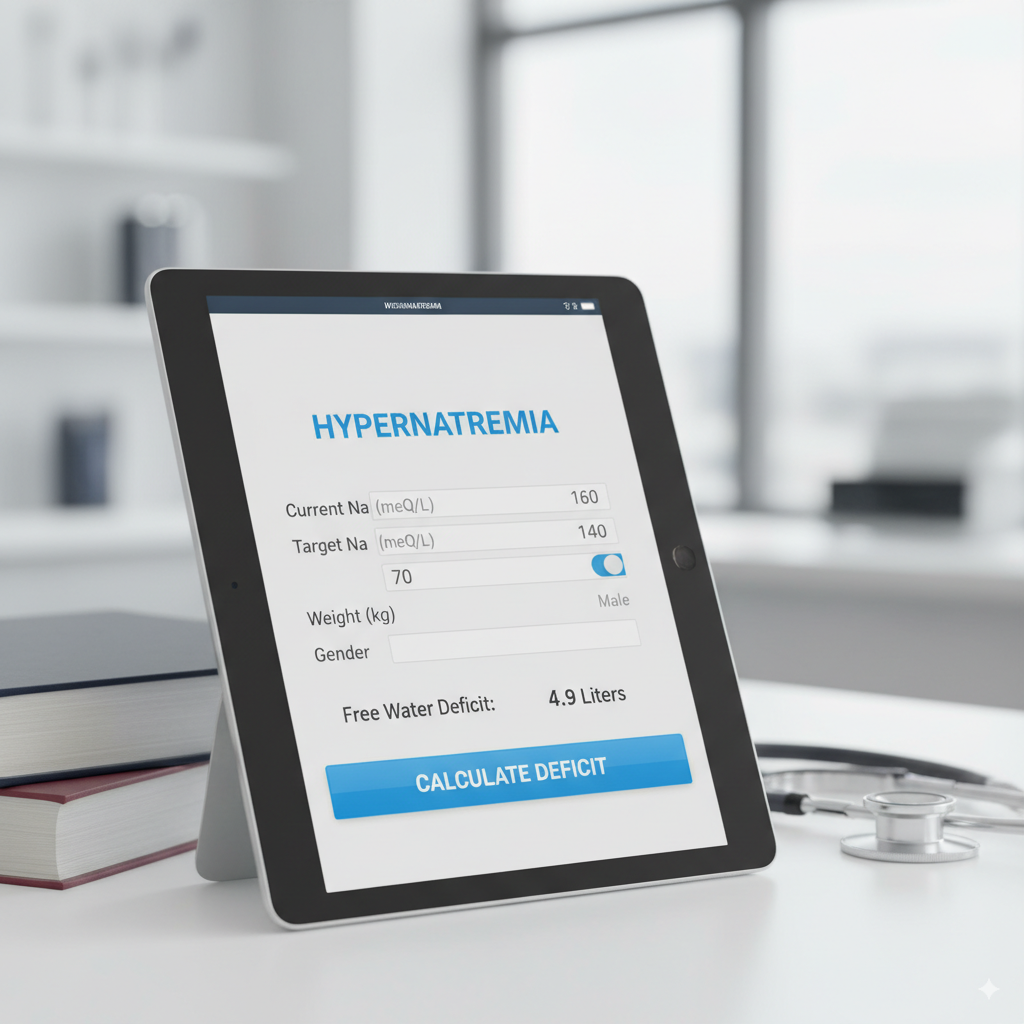Hypernatremia, a condition characterized by elevated sodium levels in the blood, requires careful management to prevent serious complications. A free water deficit calculator is a vital resource for healthcare professionals and patients alike, helping to determine the amount of free water needed to correct sodium imbalances safely. This comprehensive guide delves into how these calculators function, their clinical significance, and practical tips for effective use in patient care.
What Is a Free Water Deficit Calculator?
A free water deficit calculator is a specialized medical tool used to estimate the volume of free water required to normalize serum sodium levels in patients with hypernatremia. Hypernatremia often results from dehydration or excessive sodium intake, leading to symptoms like thirst, confusion, and in severe cases, seizures or coma. Unlike general hydration calculators, this tool focuses specifically on the body’s water deficit by accounting for total body water (TBW) and current electrolyte levels.
These calculators are commonly integrated into electronic health records, available on medical websites, or as standalone apps. By inputting patient-specific data such as weight, gender, and serum sodium concentration, the tool provides an accurate estimate of the free water deficit in liters, guiding rehydration therapy.
How Does a Free Water Deficit Calculator Work?
Free water deficit calculators employ a straightforward formula rooted in clinical physiology to compute the necessary water replacement. Here’s a step-by-step overview of the process:
- Calculate Total Body Water (TBW): TBW is estimated based on the patient’s weight and gender:
- For adult males: TBW = 0.6 × weight (kg)
- For adult females: TBW = 0.5 × weight (kg)
- Adjustments may apply for children, elderly patients, or those with altered body composition.
- Input Serum Sodium Levels: Enter the patient’s current serum sodium (Na+) concentration in mEq/L (normal range: 135–145 mEq/L). Hypernatremia is typically defined as >145 mEq/L.
- Apply the Formula: The core calculation uses the formula:
Free Water Deficit (L) = TBW × [(Current Na+ / Desired Na+) - 1]Desired Na+ is often set to 140 mEq/L for normalization.An alternative common expression is:Free Water Deficit (L) = TBW × (1 - (140 / Current Na+)) - Generate Results: The calculator outputs the total free water deficit and may suggest correction rates (e.g., no more than 0.5–1 mEq/L per hour to avoid cerebral edema).
This method ensures precise, evidence-based recommendations tailored to the patient’s physiology.
Benefits of Using a Free Water Deficit Calculator
Incorporating a free water deficit calculator into clinical practice offers numerous advantages:
- Accuracy and Efficiency: Quickly computes deficits using validated formulas, reducing manual calculation errors in fast-paced settings.
- Patient Safety: Guides safe rehydration rates, minimizing risks like osmotic demyelination syndrome from overly rapid correction.
- Personalized Care: Accounts for individual factors like gender and weight, providing customized therapy plans.
- Educational Value: Helps nurses, residents, and students understand electrolyte balance principles.
- Improved Outcomes: Supports timely interventions, potentially shortening hospital stays and preventing complications.
Factors Influencing Free Water Deficit Calculations
Several variables can affect the accuracy of free water deficit estimates:
- Patient Demographics: Age, gender, and body composition influence TBW. For instance, obese patients may require adjusted TBW factors (e.g., using lean body mass).
- Underlying Conditions: Chronic illnesses like diabetes insipidus or renal impairment alter water handling and sodium regulation.
- Severity of Hypernatremia: Acute vs. chronic cases dictate correction speeds; chronic hypernatremia allows slower repletion.
- Comorbidities: Heart failure or edema may necessitate cautious fluid administration to avoid overload.
Always correlate calculator results with clinical assessment, including vital signs, urine output, and serial sodium measurements.
How to Use a Free Water Deficit Calculator Effectively
To leverage a free water deficit calculator for optimal results, follow these best practices:
- Gather Accurate Data: Obtain recent weight measurements and lab values for serum sodium.
- Select the Right Tool: Choose calculators from reputable sources like MDCalc or Medscape for reliability.
- Interpret with Caution: Use outputs as a starting point; adjust based on the patient’s overall clinical picture.
- Monitor Progress: Recalculate periodically as sodium levels change, aiming for gradual correction (e.g., 6–8 mEq/L per day).
- Consult Guidelines: Align with protocols from organizations like the American Society of Nephrology for comprehensive management.
FAQs About Free Water Deficit Calculator — Hypernatremia
1. What is a free water deficit calculator?
A free water deficit calculator is a medical tool used to estimate how much water a patient needs to correct hypernatremia, a condition caused by elevated sodium levels in the blood.
2. Why is calculating free water deficit important?
It helps clinicians safely restore fluid balance, prevent neurological complications, and guide treatment in patients with hypernatremia.
3. How does the free water deficit calculator work?
It uses a formula that incorporates a patient’s weight, serum sodium concentration, and gender to estimate the water deficit in liters.
4. What formula is commonly used for water deficit calculation?
The most widely used equation is:
Free Water Deficit (L) = Total Body Water × ((Serum Na/140) – 1)
where Total Body Water depends on age, sex, and weight.
5. What is hypernatremia?
Hypernatremia is a medical condition where blood sodium levels exceed 145 mEq/L, often due to dehydration, excessive salt intake, or certain medical conditions.
6. Who should use the free water deficit calculator?
It’s primarily for healthcare professionals—doctors, nurses, and medical students—to estimate fluid replacement needs in patients with hypernatremia.
7. Can I use the free water deficit calculator at home?
No. This is a clinical tool intended for medical professionals. Patients should not attempt self-treatment and must consult a doctor for safe fluid management.
8. What factors affect free water deficit calculations?
Key factors include body weight, sex, total body water percentage, and current serum sodium level.
9. How is total body water (TBW) estimated?
TBW is typically 50–60% of body weight, with adjustments based on sex, age, and body composition.
10. How accurate is the free water deficit calculator?
It provides an estimate, but clinical judgment is required since underlying conditions and patient-specific factors can alter water needs.
11. What are the risks of correcting hypernatremia too quickly?
Rapid correction may cause cerebral edema, seizures, or brain damage. Guidelines recommend correcting sodium slowly (≤10–12 mEq/L per 24 hours).
12. How much water is usually replaced per day in hypernatremia treatment?
Water is generally replaced gradually over 48–72 hours, with the exact amount determined by the free water deficit and ongoing losses.
13. Can oral fluids correct hypernatremia?
Mild hypernatremia can sometimes be corrected with oral water intake, but severe cases require intravenous (IV) fluids under medical supervision.
14. What IV fluids are used for hypernatremia correction?
Common choices include 5% dextrose in water (D5W) or hypotonic saline solutions, depending on the clinical situation.
15. Is the free water deficit calculator useful for children?
Yes, but pediatric calculations require adjustments for body composition, and treatment must be carefully monitored by a pediatrician.
16. What conditions commonly cause hypernatremia?
Causes include dehydration, excessive sweating, diabetes insipidus, osmotic diuresis, and inadequate water intake.
17. Can kidney disease affect free water deficit calculations?
Yes. Patients with kidney impairment may have altered fluid handling, making calculations less reliable and requiring specialist care.
18. How do ongoing water losses affect treatment?
Ongoing losses from urine, sweat, or diarrhea must be added to the calculated water deficit to ensure adequate correction.
19. What is the safe correction rate for sodium in hypernatremia?
The recommended correction rate is ≤0.5 mEq/L per hour to avoid neurological complications.
20. Why should doctors use a free water deficit calculator instead of estimating manually?
Using the calculator reduces the risk of errors, standardizes care, and provides a clear reference for fluid management.
The Clinical Importance of Free Water Deficit Management
Managing free water deficits is a cornerstone of electrolyte disorder treatment, directly impacting patient recovery and prognosis. Hypernatremia affects approximately 1% of hospitalized patients, often in ICU settings, where dehydration from inadequate intake or excessive losses is common. A free water deficit calculator streamlines this process, enabling healthcare providers to deliver targeted therapy that restores balance without overcorrection risks.
By integrating these calculators into routine workflows, clinicians can enhance decision-making, promote evidence-based practice, and ultimately improve patient outcomes in critical care scenarios.
Conclusion
A free water deficit calculator is an indispensable aid in the precise management of hypernatremia, offering quick, reliable estimates to guide rehydration efforts. From calculating TBW to applying corrective formulas, these tools empower healthcare professionals to provide safe, personalized care. Whether in emergency departments, ICUs, or outpatient settings, incorporating a free water deficit calculator can make a significant difference in treating sodium imbalances effectively. Remember to pair calculator insights with thorough clinical evaluation and multidisciplinary input for the best results.


